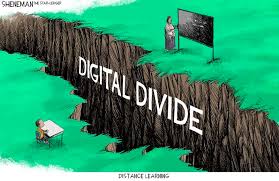1. What do you think about the framework outlined in Sieck et al.? What do you think are the most important elements in Figure 1, which is located on the second page of the article?
The framework outlined by Sieck et al. does a great job of explaining why digital inclusion is so important to health and overall well-being. I like how the authors describe digital access and literacy as a “super social determinant of health” because it influences every other social determinant—like housing, employment, education, and healthcare. Figure 1 helps visualize this by showing how internet access and digital skills are at the center of people’s ability to connect with vital resources. The most important part of the framework, to me, is how it shows that without digital inclusion, people are shut out of opportunities that many of us take for granted. It really drives home the point that digital access isn’t just about technology; it’s about equity and participation in today’s world.
2. Do you think this is a good framework to describe the impact of the digital divide? Why?
Yes, I think this framework is an effective way to illustrate the severity of the digital divide. It helps make the connection between lack of internet access and the ripple effect it has on people’s lives. The authors make it clear that digital exclusion deepens existing inequalities, which I think is true. Without access to or the skills to use technology, people can miss out on health information, job applications, education, and even communication with doctors. The idea of calling digital access a “super determinant” makes sense because it affects so many other aspects of life. Overall, the framework provides a clear understanding of why bridging the digital divide is crucial for enhancing health and social outcomes.
3. Sanders & Scanlon discuss the digital divide at some length, describing why it is a social justice issue (through page 135). Which of the areas they discussed was the most impactful for you? Were their arguments persuasive and why? Do you think they defined the problem correctly, and why or why not?
What stood out most to me in Sanders & Scanlon was their discussion about how the digital divide hits marginalized communities the hardest—especially low-income families, rural populations, and people of color. They describe digital access as a social justice issue because it’s tied to power, opportunity, and inclusion. I found their argument persuasive because they showed how digital inequality reinforces existing systems of disadvantage. I agree with how they defined the problem; they didn’t just talk about technology itself but focused on the deeper structural issues like affordability, education, and systemic inequality. Their approach made it clear that solving the digital divide means addressing these larger barriers, not just giving people devices or internet access.
4. Sanders & Scanlon then go on to describe a strategy to advocate for change regarding the digital divide (p.135 on – including the topic areas outlined). Which of those strategies did you find most promising and why? What suggestions do you think weren’t realistic or possible and why?
The most promising part of Sanders & Scanlon’s strategy was their emphasis on community partnerships and public advocacy. I liked how they encouraged collaboration with schools, libraries, and local organizations to improve digital access, since those are trusted spaces where people already go for help. Their suggestion to treat internet access like a public utility, something everyone should have, also stood out to me as a strong, forward-thinking idea. However, some of their larger-scale federal recommendations seemed a little unrealistic in the short term. Expanding broadband nationwide and achieving digital equity everywhere is a huge goal that would take time, funding, and political will. Still, their strategies overall were practical and offered a solid starting point for real change.
5. Finally, Craig et al. (2021) take the idea of technology access and discuss it in relationship to a specific client population using a specific tool. What elements of their approach do you think were most effective and why? Can you see any connections between this specific example and the problems or concerns that are raised in the other two examples?
In Craig et al., I thought the most effective part of their approach was how they used Telehealth and Affirmative Cognitive Behavioral Therapy to reach LGBTQ+ youth. This population often faces stigma and barriers when seeking mental health care, so using telehealth allowed them to access support in a more comfortable and safe environment. The combination of affirming therapy and virtual access made the intervention both inclusive and practical. This connects directly to the issues raised in the other two articles, especially the idea that technology can either bridge or widen gaps in equity. Sieck et al. and Sanders & Scanlon both discuss the dangers of digital exclusion, and Craig et al. show the flip side: how inclusive, accessible technology can empower underserved groups. Together, these articles show how important it is to ensure digital access for everyone, not just for convenience, but for health, safety, and equality.

Korie,
Well done.
Dr P